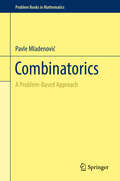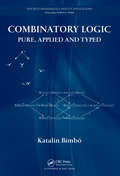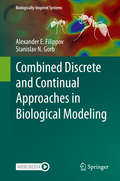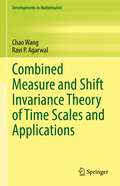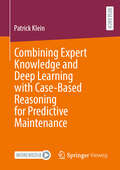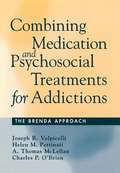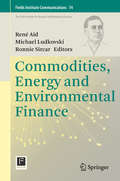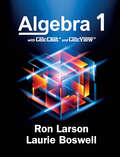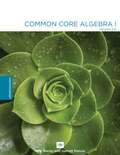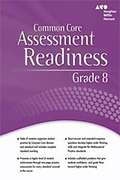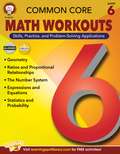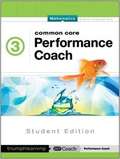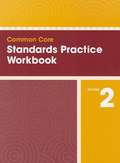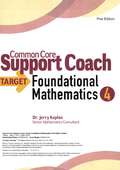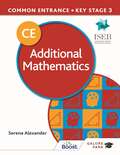- Table View
- List View
Combinatorics: A Problem-Based Approach (Problem Books in Mathematics)
by Pavle MladenovićThis text provides a theoretical background for several topics in combinatorial mathematics, such as enumerative combinatorics (including partitions and Burnside's lemma), magic and Latin squares, graph theory, extremal combinatorics, mathematical games and elementary probability. A number of examples are given with explanations while the book also provides more than 300 exercises of different levels of difficulty that are arranged at the end of each chapter, and more than 130 additional challenging problems, including problems from mathematical olympiads. Solutions or hints to all exercises and problems are included. The book can be used by secondary school students preparing for mathematical competitions, by their instructors, and by undergraduate students. The book may also be useful for graduate students and for researchers that apply combinatorial methods in different areas.
Combinatorics: Topics, Techniques, Algorithms
by Peter J. CameronCombinatorics is a subject of increasing importance, owing to its links with computer science, statistics and algebra. This is a textbook aimed at second-year undergraduates to beginning graduates. It stresses common techniques (such as generating functions and recursive construction) which underlie the great variety of subject matter and also stresses the fact that a constructive or algorithmic proof is more valuable than an existence proof. The book is divided into two parts, the second at a higher level and with a wider range than the first. Historical notes are included which give a wider perspective on the subject. More advanced topics are given as projects and there are a number of exercises, some with solutions given.
Combinatory Logic: Pure, Applied and Typed (Discrete Mathematics and Its Applications)
by Katalin BimboCombinatory logic is a versatile field that is connected to philosophical, mathematical, and computational logic. This comprehensive reference on combinatory logic covers results in the field from the last four decades along with classical information on the topic. The author makes combinatory logic simple to understand while providing working knowledge that is rigorous, current, and readable. Reader-friendly without compromising the precision of exposition, the book includes many new research results not found in the available literature. It also contains pointers to new directions in the field that can be pursued further by researchers.
Combined Discrete and Continual Approaches in Biological Modelling (Biologically-Inspired Systems #16)
by Stanislav N. Gorb Alexander E. FilippovBasic laws of nature are rather simple, but observed biological structures and their dynamic behaviors are unbelievably complicated. This book is devoted to a study of this “strange” relationship by applying mathematical modeling to various structures and phenomena in biology, such as surface patterns, bioadhesion, locomotion, predator-prey behavior, seed dispersal, etc. and revealing a kind of self-organization in these phenomena. In spite of diversity of biological systems considered, two main questions are (1) what does self-organization in biology mean mathematically and (2) how one can apply this knowledge to generate new knowledge about behavior of particular biological system? We believe that this kind of “biomimetics” in computer will lead to better understanding of biological phenomena and possibly towards development of technical implications based on our modeling.
Combined Measure and Shift Invariance Theory of Time Scales and Applications (Developments in Mathematics #77)
by Ravi P. Agarwal Chao WangThis monograph is devoted to developing a theory of combined measure and shift invariance of time scales with the related applications to shift functions and dynamic equations. The study of shift closeness of time scales is significant to investigate the shift functions such as the periodic functions, the almost periodic functions, the almost automorphic functions, and their generalizations with many relevant applications in dynamic equations on arbitrary time scales.First proposed by S. Hilger, the time scale theory—a unified view of continuous and discrete analysis—has been widely used to study various classes of dynamic equations and models in real-world applications. Measure theory based on time scales, in its turn, is of great power in analyzing functions on time scales or hybrid domains. As a new and exciting type of mathematics—and more comprehensive and versatile than the traditional theories of differential and difference equations—, the time scale theory can precisely depict the continuous-discrete hybrid processes and is an optimal way forward for accurate mathematical modeling in applied sciences such as physics, chemical technology, population dynamics, biotechnology, and economics and social sciences.Graduate students and researchers specializing in general dynamic equations on time scales can benefit from this work, fostering interest and further research in the field. It can also serve as reference material for undergraduates interested in dynamic equations on time scales. Prerequisites include familiarity with functional analysis, measure theory, and ordinary differential equations.
Combining Expert Knowledge and Deep Learning with Case-Based Reasoning for Predictive Maintenance
by Patrick KleinIf a manufacturing company's main goal is to sell products profitably, protecting production systems from defects is essential and has led to vast documentation and expert knowledge. Industry 4.0 has facilitated access to sensor and operational data across the shop floor, enabling data-driven models that detect faults and predict failures, which are crucial for predictive maintenance to minimize unplanned downtimes and costs. Commonly, a universally applicable machine learning (ML) approach is used without explicitly integrating prior knowledge from sources beyond training data, risking incorrect rediscovery or neglecting already existing knowledge. Integrating expert knowledge with ML can address the scarcity of failure examples and avoid the learning of spurious correlations, though it poses technical challenges when combining Semantic Web-based knowledge graphs with neural networks (NNs) for time series data. For his research, a physical smart factory model with condition monitoring sensors and a knowledge graph was developed. This setup generated the required data for exploring the integration of expert knowledge with (Siamese) NNs for similarity-based fault detection, anomaly detection, and automation of root cause analysis. Patrick Klein applied symbolic and sub-symbolic AI techniques, demonstrating that integrating expert knowledge with NNs enhances prediction performance and confidence in them while reducing the number of learnable parameters and failure examples.
Combining Medication and Psychosocial Treatments for Addictions: The BRENDA Approach
by Charles O'Brien Joseph Volpicelli Helen Pettinati A. McLellanRecent studies have shown combined addiction treatments to be more effective than either medication or talk therapy alone. This practical manual presents an empirically supported 6-stage framework for managing biopsychosocial treatment of alcohol and drug dependence. The BRENDA approach helps practitioners integrate emerging and established psychosocial and medical intervention approaches into a comprehensive treatment program that is tailored to the needs of the individual patient. Fully compatible with cognitive-behavioral and 12-step treatment models, BRENDA incorporates the use of newly developed medications, such as naltrexone, that target the biological underpinnings of addiction. The approach has been demonstrated effective in more than 80% of alcohol dependent referrals to the authors' treatment program. Illustrated with extended case examples, the manual describes how to conduct a thorough evaluation and assessment, select appropriate interventions, enhance the patient's motivation to change, coordinate service delivery with other providers as needed, and maximize treatment compliance. Appendices include samples of substance abuse screening instruments and information about naltrexone pharmacotherapy.
Commodities, Energy and Environmental Finance (Fields Institute Communications #74)
by René Aïd Ronnie Sircar Michael LudkovskiThis volume is a collection of chapters covering the latest developments in applications of financial mathematics and statistics to topics in energy, commodity financial markets and environmental economics. The research presented is based on the presentations and discussions that took place during the Fields Institute Focus Program on Commodities, Energy and Environmental Finance in August 2013. The authors include applied mathematicians, economists and industry practitioners, providing for a multi-disciplinary spectrum of perspectives on the subject. The volume consists of four sections: Electricity Markets; Real Options; Trading in Commodity Markets; and Oligopolistic Models for Energy Production. Taken together, the chapters give a comprehensive summary of the current state of the art in quantitative analysis of commodities and energy finance. The topics covered include structural models of electricity markets, financialization of commodities, valuation of commodity real options, game-theory analysis of exhaustible resource management and analysis of commodity ETFs. The volume also includes two survey articles that provide a source for new researchers interested in getting into these topics.
Common Core Algebra 1 with CalcChat + CalcView
by Ron Larson Laurie BoswellCommon Core Algebra 1 with CalcChat + CalcView
Common Core Algebra I
by Kirk Weiler Garrett MatulaThis workbook contains over 100 lessons and homework sets that cover the PARCC End of Year Standards from the Common Core Curriculum. <p><p> Unit 1 – The Building Blocks of Algebra <p>Unit 2 – Linear Expressions, Equations, and Inequalities <p>Unit 3 – Functions <p>Unit 4 – Linear Functions and Arithmetic Sequences <p>Unit 5 – Systems of Linear Equations and Inequalities <p>Unit 6 – Exponents, Exponents, Exponents and More Exponents <p>Unit 7 – Polynomials <p>Unit 8 – Quadratic Functions and Their Algebra <p>Unit 9 – Roots and Irrational Numbers <p>Unit 10 – Statistics <p>Unit 11 – A Final Look at Functions and Modeling
Common Core Clinics, Mathematics, Ratios and Proportional Relationships; Expressions and Equations, Grade 7
by Colleen O'DonnellNIMAC-sourced textbook
Common Core Clinics, Mathematics, Statistics and Probability, Grade 7
by Colleen O'DonnellNIMAC-sourced textbook
Common Core Clinics, Mathematics, The Number System, Grade 7
by Colleen O'DonnellNIMAC-sourced textbook
Common Core Geometry (Grade 9/10)
by Prentice-Hall StaffThroughout this textbook, you will find content that has been developed to cover many of the Standards for Mathematical Content and all of the Standards for Mathematical Practice from the Common Core State Standards for Mathematics. The End-of-Course Assessment provides students with practice with all of the Standards for Mathematical Content listed on pages xvi to xix.
Common Core Math Workouts, Grade 6
by Karice Mace Keegen GennusoEach page in Common Core Math Workouts for grade 6 contains two Òworkouts"; one for skills practice and one for applying those skills to solve a problem. These workouts make great warm-up or assessment exercises. They can be used to set the stage and teach the content covered by the standards. They can also be used to assess what students have learned after the content has been taught. Content is aligned with the Common Core State Standards for Mathematics and includes Geometry, Ratio and Proportional Relationships, The Number System, Expressions and Equations, and Statistics and Probability. The workbooks in the Common Core Math Workouts series are designed to help teachers and parents meet the challenges set forth by the Common Core State Standards. They are filled with skills practice and problem-solving practice exercises that correspond to each standard. With a little time each day, your students will become better problem solvers and will acquire the skills they need to meet the mathematical expectations for their grade level.
Common Core Mathematics State Standards, Grade 7
by Perfection LearningThis book will help you review, practice, and master the Common Core State Standards for Mathematics. Here are the steps to follow to use this book. <p><p> 1. Take the Tryout Test and check your answers. Use the chart at the bottom of this page to find out your strengths and weaknesses in the areas covered. Don't be discouraged if you don't get all the answers right or if you don't understand some questions. Remember the questions that are hard for you to answer. They will be the types of questions you need to work on the most. <p> 2. Work through the lessons that follow the Tryout Test. Each lesson reviews example items and provides a practice test based on the Common Core State Standards. Fill in the Keeping Score chart on page 127 as you complete each practice test. <p> 3. After completing all the lessons, take the Mastery Test. Your score on this test will show your understanding of the Common Core State Standards for Mathematics.
Common Core Performance Coach Grade 3 Mathematics
by Triumph Learning LlcKey concepts and skills are reintroduced that are a prerequisite to mastering grade-level content.
Common Core Support Coach Target Foundational Mathematics 4
by Jerry KaplanCommon Core Support Coach Target Foundational Mathematics 4
Common Entrance 13+ Additional Mathematics for ISEB CE and KS3
by Serena AlexanderExam board: ISEB Level: 13+ CE and KS3 Subject: Mathematics First teaching: September 2021 First exams: November 2022Serena Alexander brings her renowned passion and love of Mathematics to help you stretch and challenge pupils aiming for the Additional Mathematics paper or the Common Academic Scholarship Exam (CASE). The resource is packed with activities, examples and exercises to help pupils develop a comprehensive knowledge of Mathematics.· Push your pupils to achieve high scores: Covers all content for the Core Mathematics paper, with new material for the Additional Mathematics paper and the Common Academic Scholarship Exam (CASE).· Ensure an in-depth knowledge of Mathematics: Chapters include Fractions and Decimals, Geometry (with more of a focus on angle calculations using algebra), and Trigonometry.· Develop a wider understanding with projects: End-of-chapter projects and investigations cover current affairs, mathematical proof and mathematical paradox, and using probability to model real-life scenarios.· Support your pupils in developing their analytical and research skills: Investigations include Mersenne primes, perfect numbers and Goldbach's conjecture.· Encourage your pupils to think beyond Mathematics: Cross-curricular boxes inform pupils where mathematical skills may be required in other subjects (including other examination subjects, PSHEE and ICT) with suggestions of cross-curricular activities.· Guide your pupils to develop an understanding of the role of Mathematics in the world: SCEE (Social, Cultural, Empathy and Environmental) boxes encourage pupils to learn the mathematical relevance in society, links to different cultures including their role in the history of Mathematics, and the use of Mathematics in exploring environmental issues.Accompanying answers available in a paid-for PDF download at galorepark.co.uk (ISBN: 9781398321403).
